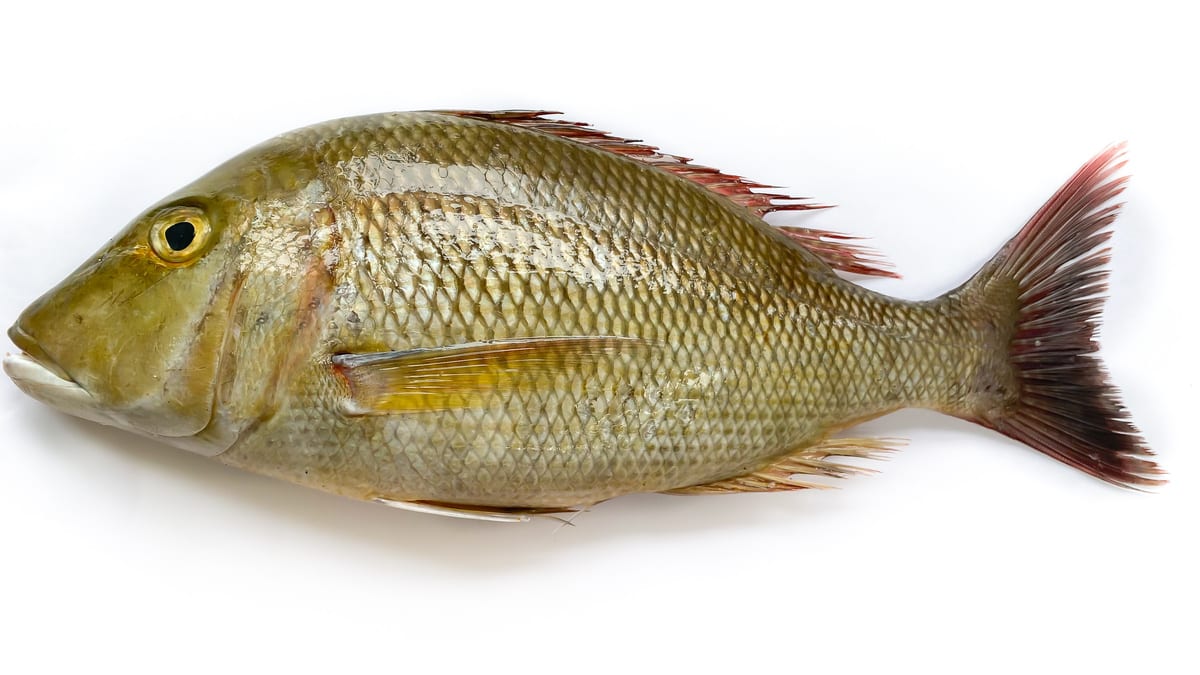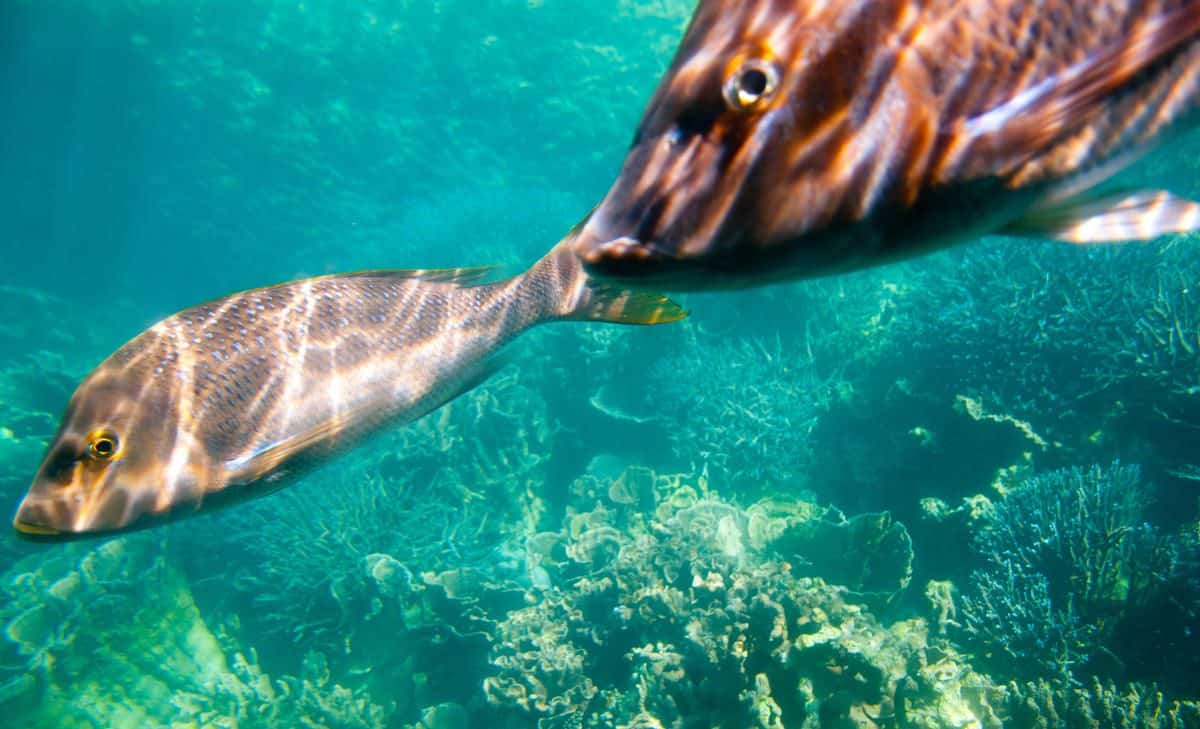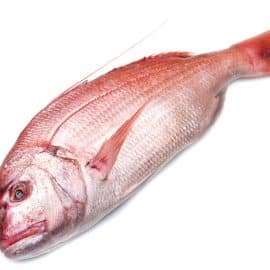
Introduction
The Emperor Fish, Lethrinidae, is a majestic creature that has captivated the hearts and minds of onlookers for centuries. Aptly named for its exquisite appearance, this formidable fish has been described as having a “regal air” with its striking colours and impressive size. It’s said to have an almost otherworldly presence that draws one in and demands admiration.
As intriguing as it is beautiful, the Emperor Fish is an incredible species found in many tropical waters worldwide that can live up to thirty years old. They are found in shallow coral reefs and beds of seagrass and are considered a delicacy worldwide.
They are found in large groups and enjoyed by many city dwellers and fishermen alike. The taste and texture of this food are what make it so popular. In addition to being less oily, Emperor fish have a pleasantly sweet taste.
Description & Characteristics
The Emperor Fish is a reef-associated fish found in the Indo-Pacific region’s tropical and subtropical waters. It is a member of the family Lethrinidae within the order of Perciformes. They go by many names, including green snapper, spangled emperor, sand bream, morwong, north-west snapper, sand snapper, and sweetlip.
Adults range from 40 to 70 cm in length and are typically brown with yellow and orange spots over their entire body. Their bodies are oval-shaped and have a broad head profile with a small mouth. They have large eyes, a large mouth with thick lips, and prominent canine teeth.
The dorsal fin has nine spines and 14 to 16 soft rays, while the anal fin has three spines and seven to eight soft rays. The colouration of their scales changes depending on the area they live in; some species may be greyish or yellowish-brown on top, fading to white underneath. Some may also have reddish spots or stripes on their sides. Juveniles often have different patterns than adults due to their age and environment.
They are not considered social fish but may form loose schools when feeding or during spawning events.

Types of Emperor Fish
This colourful family is known for their distinctive snouts, enormous eyes, and large lips, thus earning them the name yellow sweetlips. Emperor fish are most commonly caught commercially in the following species:
Spangled or Blue Emperor fish (Lethrinus nebulosus and Lethrinus sp.)
Spangled emperor is the largest and most coveted member of the Emperor family. Generally, they have pale yellow skin with pale bluish patches on their faces, with flecks of bluish brown on their bodies.
Redspot Emperor fish(Lethrinus lentjan)
Its pectoral fin is red, which distinguishes it from other Emperors. The average weight of this emperor is about 600 grams, making it one of the smallest.
Redthroat Emperor (Lethrinus miniatus)
There are many bright red markings on this Emperor fish, and its flesh is the most white of all Emperor fishes. In addition, its snout has a distinct point, its eyes are big, and its lips are thick.
The skin should be lustrous, the flesh should be firm, and the fish should smell fresh and pleasant. When choosing fillets, select those that are smooth, moist, white, free from brown marks and moisture, and have a pleasant smell of fresh seawater.
Longnose Emperor (Lethrinus olivaceus)
One of the most slender Emperor fish, it is also the most colourless, having an olive-grey skin colour.
Grass Emperor (Lethrinus laticaudis)
Spangled Emperors are most closely related to this variety. Its cheeks do not have scales, but its pectoral fin base is heavily scaled.
This species has brown, yellow, or tan bodies speckled with random patterns; the head has a brown or yellow colour with bluish spots on the cheeks and a blue band behind and in front of the eyes; and a mottled vertical fin.
Biology
Emperor fish have several unique features that set them apart from other species of marine life. They have thick and sturdy scales, helping to protect them from predators. Other features include strong jaws with sharp teeth and powerful fins, which help them swim quickly through the water.
The biology of the emperor fish includes the following:
- Reproduction: Emperor fish reproduce by spawning; during this process, females release hundreds of thousands of eggs into the open ocean, and males fertilise them externally after they are released.
- Feeding Habits: Emperor fish primarily feed on molluscs, crustaceans, sea urchins, and small fishes. They use their strong jaws to crush hard shells and sharp teeth to tear apart fleshy prey items such as octopi or squid.
- Behavior: Emperor fish exhibit a variety of behaviour, including cooperative hunting, cleaning symbiosis with other species, forming harems during mating season, and showing parental care for young offspring.
- Anatomy: The emperor fish has a streamlined body covered with thick scales for protection against predators and a smooth head with prominent eyes near the top for better visibility when hunting for food underwater. Additionally, they possess powerful fins which allow them to swim quickly through the water in pursuit of prey or escape from predators.
- Physiology: Emperor Fish have several physiological adaptations that help them survive in their environment, such as colour-changing abilities that allow them to hide from predators or attract mates during spawning season. They also possess an acute sense of smell that allows them to detect food sources at great distances from their present location.
These intriguing creatures offer an interesting insight into the complex biology of marine life and provide researchers with valuable information about how certain species interact within their ecosystems.
Species And Taxonomy
The emperor fish belongs to the family Lethrinidae, which includes other large predatory fishes. This species usually inhabits shallow sandy areas near coral reefs such as the Great Barrier Reef, where it is often seen feeding on smaller fish and crustaceans.
In taxonomy, the emperor fish belongs to the family Lethrinidae, subfamily Lethrininae. Its scientific name is derived from the Latin words for ‘large’ (lethrus) and ‘spotted’ (mahsena).
Habitat & Distribution
The Emperor Fish, also known as the Lunartail, is an Indo-Pacific fish with a wide range. They are typically found in coastal waters and lagoons from East Africa, the Red Sea, to the far east, like in Hawaii and French Polynesia. They inhabit shallow reefs, estuaries, and seagrass beds in depths of up to 30 meters.
Emperor Fish’s Diet
The diet of emperor fish is diverse and varied, from their larvae to their adult stage.
In the wild, emperor fish feed on a wide range of items, including crustaceans such as crabs and shrimp, molluscs like clams, small fishes like anchovies, various algae, and plankton. They also consume smaller amounts of squid and jellyfish when they are available.
During their juvenile stage, they tend to feed more on zooplankton, while in their adult stage, they rely primarily on more oversized prey items such as fish.
Their diet also varies with the season; they generally switch to eating benthic organisms during winter when less plankton is available in the water column.

Life Cycle of Emperor Fish
Spawning for emperor fish typically occurs during the spring and summer months. Males actively search for females, using their head-down swimming pattern to attract mates. The female then releases her eggs fertilised by the male’s milt in what is known as a “spawning rush.” This graceful spectacle is likened to two underwater ribbons moving swiftly together in harmony beneath the waves.
Once fertilised, the eggs drift in the ocean currents until they hatch into larvae. The larvae are planktonic organisms that float on top of the water column until they mature into juveniles.
As juveniles grow, they hunt and feed on other fish species, such as small invertebrates or crustaceans. They eventually reach adulthood when they reach a length of around 40 centimetres. Emperor fish can live up to 8 years in their natural habitat.
Adult emperor fish continue their nomadic lifestyle by migrating across vast distances within oceans or seas before returning to spawn again at the exact location from whence they came – as a never-ending loop journeyed along ancient pathways established long ago.
Emperor Fish Fisheries
The fisheries for emperor fish are vast and highly productive. Emperor fish is found in tropical and subtropical waters of the Indian, Pacific, Atlantic Oceans, and Mediterranean Sea. It is a popular target for commercial fishermen and recreational anglers due to its large size, delicious flavour, and wide availability.
In some parts of the world, such as Australia, emperor fish is managed by quotas or minimum size limits set by government authorities to ensure sustainable populations. Additionally, various gear restrictions are in place to reduce the impact of fishing on other species or habitats.
In other areas, however, like most parts of Southeast Asia or South America, there are no regulations or management strategies to protect emperor fish populations from overfishing. This can lead to unsustainable levels of exploitation and long-term damage to local ecosystems.
Sustainability
The sustainability of emperor fish is a contentious issue. While some believe it can be a sustainable resource, others argue that its fishing methods are unsustainable and could adversely affect the marine environment.
To understand this debate, it is vital to consider the following three components: the fishing practices used to catch emperor fish, current regulations to manage the fishery, and potential conservation efforts needed to ensure sustainability.
Fishing techniques used to catch emperor fish vary widely and include trawling, purse seining, long-lining, handline fishing and gillnetting. Trawling involves dragging a large net along the seafloor to capture fish in its path, while purse seining encircles schools of fish with a large net and then cinches it closed like a purse. Long-lining involves setting hundreds or thousands of baited hooks attached along one line, while handline fishing requires anglers to use rods and reels for individual catches. Lastly, gillnetting uses nets suspended in the water column that entangle passing fish by their gills when they swim through them.
Regulations on harvesting emperor fish currently exist but must be consistently enforced effectively due to jurisdictional issues or lack of resources. For example, many countries have established minimum size limits and seasonally restricted areas for emperor fishing. Still, these policies may need to be appropriately monitored or enforced due to inadequate funding or personnel shortages.
In addition, most countries still need policies that regulate how many fish can be caught from each area over time or how much gear can be deployed, making it difficult for fisheries managers to monitor activities to ensure the sustainability of the fishery.
For emperor fisheries to remain sustainable into the future, several conservation measures need to be implemented, including more effective enforcement of existing regulations; better tracking systems for vessels and gear; improved data collection on catch levels; and incentives for local fishermen who practice sustainable methods such as using circle hooks rather than long-lines or other potentially destructive gear types.
Additionally, increasing public awareness about reliable catch methods and sustainable seafood consumption will help further reduce impacts on this valuable species.

Emperor Fish As Food
Emperor Fish is an important food source for many cultures around the world. Its mild flavour and firm texture make it popular for cooking and eating. As a result, it has become an essential part of many cuisines and is used in various dishes.
When preparing emperor fish, there are some essential points to consider. Firstly, it needs to be cleaned before cooking or eating, as unclean fish may contain contaminants that can harm humans if ingested. Secondly, the flesh must be cooked appropriately, which will cause it to become tough and lose its flavour. Finally, when selecting emperor fish for consumption, ensure it is fresh and handled with care throughout the supply chain.
The taste of cooked emperor fish varies depending on the plate or prepared dish. Generally speaking, its mild flavour pairs well with other ingredients, such as herbs and spices, making it a versatile ingredient in recipes. Its firm texture also makes it ideal for grilling or baking, as it holds up well during cooking. Additionally, its light oiliness provides a pleasant flavour when cooked in different styles, such as steaming or pan-frying.
With these factors in mind, one can create delicious meals with emperor fish that are both healthy and tasty.
How To Prepare Emperor Fish
The most common preparation method for emperor fish is deep-frying. This cooking technique results in a crispy outside and a moist interior. The mild, sweet flavour of the fish pairs well with a variety of seasonings or sauces, such as lemon juice, garlic butter, or soy sauce.
Other popular preparation methods include grilling, baking, steaming, or poaching. Many recipes for emperor fish also include vegetables such as potatoes and peppers as accompaniments to the meal.
Grilled emperor fish can be cooked on an outdoor grill or in an oven. When grilling, it’s vital to ensure that the fillets are cooked through and evenly browned on both sides.
Baking the fish in the oven is another popular method and can be done with a sauce or marinade. Additionally, some chefs choose to fry emperor fish in oil to give it a crispy texture.
No matter which cooking method you choose, ensure your fillets are thick enough so they don’t dry out during cooking. It is also important to season your fillet before cooking; use salt and pepper and other herbs and spices of your choice to enhance the dish’s flavour.
To help keep the fish moist while cooking, baste it periodically with butter or olive oil for added flavour and texture. With these tips in mind, you can easily prepare delicious grilled, baked, or fried emperor fish for any occasion!
Best Side Dishes Paired With Emperor Fish
When preparing emperor fish, the side dishes that pair best with its mild flavour are just as important as the main entree. A variety of ingredients and flavours can be used to complement the delicate taste of this seafood delicacy. Here are some popular sides that will help bring out the best in any meal featuring emperor fish:
First, herbs and spices such as thyme, dill, and rosemary can add a subtle flavour that won’t overpower the fish’s delicate taste. Second, vegetables like grilled or steamed asparagus, eggplant, and squash provide a nutritious accompaniment to any emperor fish dish. Third, adding a light sauce such as white wine butter sauce or citrus-based vinaigrette helps bring out the natural sweetness of this type of fish. Finally, adding a grain such as wild rice or quinoa can add texture and nuttiness to any dish.
These side dishes make a great addition to any meal featuring emperor fish. They offer complimentary but distinct flavours that enhance rather than overwhelm this classic seafood staple. With these simple yet flavorful sides, you’ll be able to turn an ordinary dinner into an extraordinary one in no time!
Comparison To Other Fish
As an example of how emperor fish differ from other types of seafood, they have a significantly higher fat content than most other types of fish. In particular, emperor fish contain more omega-3 fatty acids than most other seafood sources. This makes them a more healthful option for those looking to increase their intake of healthy fats while avoiding the saturated fats found in other types of seafood.
Furthermore, emperor fish are considered a good source of protein and provide significant amounts of vitamins and minerals such as zinc and selenium.
In contrast to other types of seafood, emperor fish are relatively low in mercury content compared to larger predator species such as tuna or swordfish. Therefore, they can be safely consumed by adults and children alike without having to worry about potential health risks associated with mercury poisoning.
Additionally, emperor fish tend to be lower in price than many other varieties of seafood due to their abundance in tropical regions worldwide. All these factors make them an ideal choice for a high-quality but affordable source of protein and healthy fats.
Conclusion
The emperor fish is a species that has been around for many centuries and continues to thrive in its natural environment and aquaculture systems throughout the world.
Despite its small size, it provides substantial nutritional value and can be cooked using various methods to bring out its unique flavour profile. They are typically sold fresh or frozen at marketplaces throughout their range.
